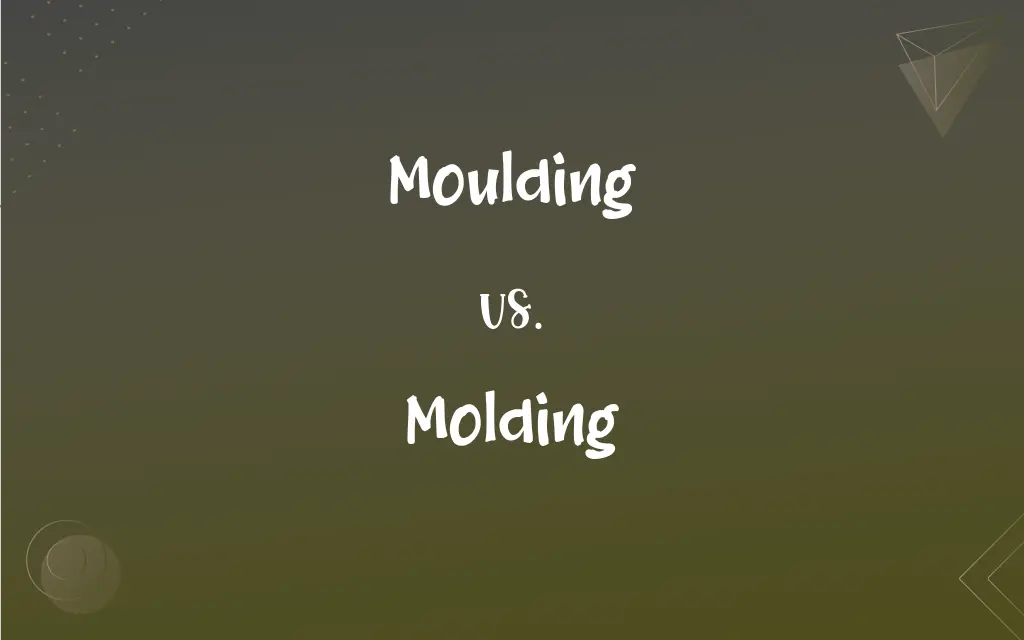Moulding vs. Molding: What's the Difference?
Edited by Aimie Carlson || By Harlon Moss || Updated on November 9, 2023
Moulding and molding are different spellings of the same word; "moulding" is British, and "molding" is American, both refer to the process of shaping a pliable material.

Key Differences
Moulding, in British English, and molding, in American English, describe the act of forming something into a particular shape. The usage of moulding versus molding does not alter the basic definition of the term, which is the process of shaping a fluid or malleable material using a rigid frame called a mold. In both cases, the term can refer to a strip of material with various profiles used for decoration on walls, ceilings, or furniture.
The term moulding is used in various contexts in British English, ranging from the act of shaping clay in art to the process of forming plastics in manufacturing. Similarly, molding in American English encompasses these same contexts. The spelling difference does not denote a difference in meaning but rather reflects a variance in regional spelling conventions.
In the construction and manufacturing industries, moulding often refers to decorative strips and architectural accents in British contexts, whereas molding in American contexts would carry the same meaning. The terms are interchangeable in practice, with the choice of spelling being the only difference.
The process of creating a mould/mold itself is also denoted by these terms. Moulding in British English and molding in American English can both refer to the process of creating a cavity or form that shapes liquid or semi-liquid substances into a fixed design as they solidify.
Moulding and molding can both be used as nouns to describe the result of this process. Whether it's a moulding on a picture frame or a molding on a piece of classic American architecture, the words describe the finished product that has been shaped from a material using a mold.
ADVERTISEMENT
Comparison Chart
Spelling
Moulding
Molding
Usage
Primarily in regions using British English
Primarily in regions using American English
Lexicography
Appears in Oxford English Dictionary
Appears in Merriam-Webster Dictionary
Industry Reference
Used in British manufacturing and construction
Used in American manufacturing and construction
Literature
Found in British literature and publications
Found in American literature and publications
ADVERTISEMENT
Moulding and Molding Definitions
Moulding
The pattern or structure produced by moulding.
The moulding on the cornice was starting to crack and peel.
Molding
The act of influencing or forming character or habits.
Her mentor was instrumental in molding her career.
Moulding
The process of shaping material in a mold.
The artist spent hours on moulding the clay into a beautiful vase.
Molding
The pattern or structure produced by molding.
The intricate molding of the figurine was admirable.
Moulding
A frame or template for casting or shaping material.
He used a wooden moulding to create the candle's unique form.
Molding
The process of shaping material in a mold.
Molding the molten metal required precision and care.
Moulding
The act of influencing or forming character or habits.
His time in the military played a significant role in moulding his discipline.
Molding
A frame or template for casting or shaping material.
The ceramic pot was made using a specialized molding.
Moulding
Variant of molding.
Molding
The act or process of molding.
Moulding
Present participle of mould
Molding
Something that is molded.
Moulding
(British spelling) molding.
Molding
An embellishment in strip form, made of wood or other structural material, that is used to decorate or finish a surface, such as the wall of a room or building or the surface of a door or piece of furniture. Also called mold1.
Moulding
A sculpture produced by molding.
Molding
Present participle of mold
Moulding
A decorative recessed or relieved surface.
Molding
The act or process of shaping in or on a mold, or of making molds; the art or occupation of a molder.
Moulding
A decorative strip used for ornamentation or finishing.
Molding
Anything cast in a mold, or which appears to be so, as grooved or ornamental bars of wood or metal.
Moulding
A preliminary sculpture in wax or clay from which a finished work can be copied.
Molding
(architecture) A plane, or curved, narrow surface, either sunk or projecting, used for decoration by means of the lights and shades upon its surface and to conceal joints, especially between unlike materials.
Moulding
A decorative strip used for ornamentation or finishing
Molding
(woodwork) A planing machine for making moldings.
Moulding
A decorative recessed or relieved surface on an edge
Molding
(founding) A machine to assist in making molds for castings.
Moulding
Sculpture produced by molding
Molding
(milling) A mill for shaping timber.
Moulding
A preliminary sculpture in wax or clay from which a finished work can be copied
Molding
(founding) A kind of sand containing clay, used in making molds.
Molding
The act or process of shaping in or on a mold, or of making molds; the art or occupation of a molder.
Molding
Anything cast in a mold, or which appears to be so, as grooved or ornamental bars of wood or metal, or sculptures.
Molding
A decorative strip used for ornamentation or finishing.
Molding
A preliminary sculpture in wax or clay from which a finished work can be copied.
Molding
Used in making a mold or moldings; used in shaping anything according to a pattern.
Molding
The act of creating something by casting it in a mold
Molding
A decorative strip used for ornamentation or finishing
Molding
A decorative recessed or relieved surface on an edge
Molding
Sculpture produced by molding
Molding
A preliminary sculpture in wax or clay from which a finished work can be copied
FAQs
Is "moulding" the same as "molding"?
Yes, "moulding" is the British spelling, and "molding" is the American spelling of the same word.
Is "molding" only related to construction?
No, "molding" can refer to any process of shaping a material or the decorative elements made by this process.
Is the spelling "molding" accepted in the UK?
It may be understood, but "moulding" is the preferred UK spelling.
Can "moulding" be used in American English?
While not common, "moulding" can be understood in American English but "molding" is the conventional spelling.
Does "moulding" have an alternative meaning in British English?
Beyond shaping materials, it does not have a significantly different meaning.
Are there any contexts where "moulding" or "molding" mean different things?
No, in all contexts related to shaping materials, they mean the same thing.
Can "moulding" refer to a process in cooking?
Yes, "moulding" can refer to shaping food items, like in chocolate moulding.
What materials can be used in "molding"?
"Molding" can involve materials like plastic, metal, wood, or clay.
Can "moulding" be used metaphorically?
Yes, it can describe the process of developing a person's character or skills.
Are there any spelling variations of "moulding" or "molding"?
No, these are the primary variations between British and American English.
In literature, which form is more common?
It depends on the origin of the literature; British works use "moulding," American works use "molding."
Do "moulding" and "molding" have the same plural forms?
Yes, both are pluralized as "mouldings" or "moldings" respectively.
Is there a difference in pronunciation between "moulding" and "molding"?
No, they are pronounced the same way.
Can "moulding" and "molding" be used as verbs?
Yes, they can describe the action of creating a shape using a mold.
Are "moulding" and "molding" used in art?
Yes, both terms can be used in art to describe the shaping of materials.
Can "molding" refer to a finished product?
Yes, it can refer to the finished shape or decorative element that was formed using a mold.
Are there different types of "moulding"?
Yes, there are various types such as crown, baseboard, and chair rail moulding.
Can "moulding" be spelled without the 'u' in British English?
Typically, no, British English favors the 'u' in the spelling.
Does "molding" always involve a physical mold?
Most often, yes, but it can also refer to the act of influence or training.
Is "molding" a modern word?
The concept is ancient, but the word has evolved with the English language.
About Author
Written by
Harlon MossHarlon is a seasoned quality moderator and accomplished content writer for Difference Wiki. An alumnus of the prestigious University of California, he earned his degree in Computer Science. Leveraging his academic background, Harlon brings a meticulous and informed perspective to his work, ensuring content accuracy and excellence.
Edited by
Aimie CarlsonAimie Carlson, holding a master's degree in English literature, is a fervent English language enthusiast. She lends her writing talents to Difference Wiki, a prominent website that specializes in comparisons, offering readers insightful analyses that both captivate and inform.































































